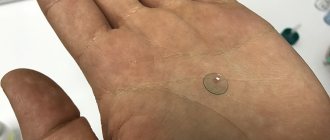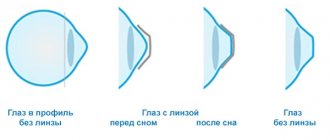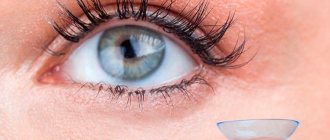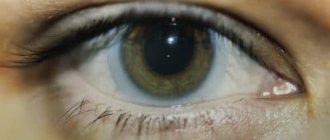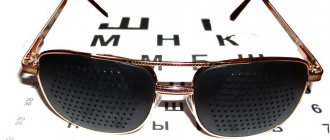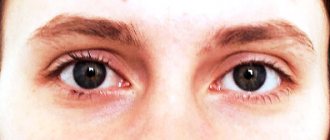"Optics Kronos" - only modern methods of vision correction!
Kronos Optics is ready to offer you the most modern method of non-surgical vision correction: refractive therapy using Paragon CRT night contact lenses. You simply put the lenses on at night and take them off in the morning. The result is 100% vision without glasses or contact lenses for 24 hours or more.
Lens parameters
| Overall Diameter (D) | 9.5 to 12.0 mm |
| Radius of curvature of the central base | From 6.50 to 10.50 mm |
| Half-chord of the optical zone (OZ) | 2.50 to 3.50 mm |
| Return zone width (w) | From 0.75 to 1.5 mm |
| Return zone depth (Δ) | No more than 1.0 mm |
| Landing zone radius | to infinity |
| Landing zone angle (φ) | From –25 to –50º |
| Landing Zone Width (LZW) | From 0.5 to 2.75 mm |
| Edge Edge Width (P) | From 0.04 mm to LZW |
| Dioptric power | –2.00 to +2.00 dioptres |
Paragon CRT ® 100 contact lenses are made of Paragon HDS ® 100 material, which is a thermosetting copolymer of fluorosilicone acrylate with a water content of no more than 1%.
CHARACTERISTICS OF PARAGON CRT ® 100 LENSES (paraflucon D)
| Refractive index | 1.442 (Nd at 25ºС) |
| Light transmittance * (green) | 95 % |
| Contact Angle (Incidence Angle) | 42º |
| Specific gravity | 1,10 |
| Hardness (Shore D) | 79 |
| Water content | < 1 % |
* Determination of luminous transmittance and spectral transmittance, ISO 8599:1994.
| OXYGEN PERMEABILITY OF CRT ® LENSES | |||||||
| Material | Force | Oxygen permeability (Modified Fett method)* Dk x 10-11 | Oxygen permeability (ISO method**) Dk x 10-11 | Center thickness (mm) | Average harmonic thickness*** (mm) | Transmitting capacity for oxygen (according to Fett) Dk/l x 10-9 | Oxygen transfer capacity (ISO) Dk/l x 10-9 |
| HDS 100 | -2,00 | 145 | 100 | 0,145 | 0,163 | 89 | 61 |
| HDS 100 | Flat | 145 | 100 | 0,163 | 0,166 | 87 | 60 |
| HDS 100 | +2,00 | 145 | 100 | 0,180 | 0,168 | 86 | 60 |
* (cm2/s) (ml O2) / (ml x mm Hg) Modified I. Fett method ** (cm2/s) (ml O2) (ml x mm Hg) ISO/ANSI method, ISO 9913-1 ** * Semmons, W. A., “Contact Lens Thickness and More,” The Optician, 5/12/80.
Return to top
Risk Analysis
There is a certain risk when wearing contact lenses . But the risk of using Paragon CRT ® 100 contact lenses for corneal refractive therapy no greater than the risk of using other rigid gas permeable contact lenses.
The occurrence of side effects is minimized with proper monitoring of the lenses by the patient. Patients must be taught the rules of lens care, how to put on and remove lenses. Patients should be informed to remove contact lenses if unusual signs are detected. Patients should be taught to never wear contact lenses in the presence of harmful substances. Patients should also understand the importance and necessity of further visits to the ophthalmologist.
Return to top
Selection rules
Night lenses – which ones are better? You can purchase orthokeratological hard night lenses at a contact correction laboratory or optics office. They can only be selected by an ophthalmologist who has completed special training courses and has all the necessary skills. You cannot make a choice on your own.
A person who has previously worn soft contact lenses should stop wearing them for 2 weeks. Only after this can he go for a consultation with a specialist.
The selection of lenses begins with an examination, which includes:
- determination of visual acuity;
- refractometry;
- keratotopography;
- keratometry;
- other necessary studies.
The choice of orthokeratology lenses is quite complex, which is why the specialist has to review several options. As a result, the doctor chooses the correction tool that best suits all parameters. The person puts on the lenses and sleeps in them for 6-7 hours, then comes in for a second examination. If they fit, the doctor allows you to use them constantly.
The most popular nowadays are Paragon night lenses. They can be purchased at many opticians and even ordered online. Note that when purchasing them, a person receives a free consultation with an ophthalmologist.
Lens operating principle
Let's figure out how night lenses work. They compress the cornea, thereby correcting its shape. In this case, only the thickness of the epithelium—the thin superficial layer of the cornea—changes in humans. The stroma and endothelium remain unchanged.
A person puts on hard lenses at night and goes to bed calmly. While he is resting, the devices do their work. They gently press on the cornea, correcting irregularities, correcting thickness, shape and curves. After waking up, the person removes the therapeutic night lenses and goes about his business. He has good vision all day.
Validity
Previously, doctors were sure that orthokeratological hard lenses had only a temporary effect, and after their removal, the cornea soon returned to its former shape. However, recent scientific research has proven otherwise. As it turned out, with many months of use, hard lenses can cause a lasting effect. In children who wore them for about 4 years, minor changes in the cornea persisted for more than two weeks.
Modern nighttime eye lenses can correct vision for one to three days. The duration of their action depends on the degree of myopia and the individual characteristics of the human eye. Immediately after removing the lenses, visual acuity rises to 100%, but in the evening it drops by 0.5-0.75 diopters.
Selection concept
Paragon CRT ® 100 corneal refractive therapy contact lenses are designed to realign the central cornea and thereby reduce myopia. This goal is achieved through the design of the lens and the way it is mounted.
The goal of fitting is a well-centered lens that has a base curvature less than the curvature of the flattest meridian of the cornea, at least by the degree of treatment required on that meridian.
A well-placed lens will have the proper sagittal depth to prevent tilt and achieve centering at the apex of the cornea. A well-fitted lens will also have a proper sagittal depth profile to prevent the corneal edge from touching the corneal surface.
The lens will provide applanation of the central cornea, a paracentric gap between the lens and the cornea, and tangential alignment of the Landing Zone to the cornea.
There are four main goals of selection:
- providing a base curvature that should change the shape of the cornea underneath to produce a resulting curvature leading to emetropia or slight hypermetropia;
- providing a return zone that regulates the depth of the lens and influences the formation of the tear profile;
- providing a landing zone that has the proper angle to obtain a midpoint of contact with the cornea;
- ensuring a lens diameter that, together with the Landing Zone angle, gives optimal centering.
Predictability of results
Paragon CRT ® 100 contact lenses for corneal refractive therapy can provide temporary full or partial reduction of patients' myopia . The amount of reduction will depend on many factors, including the degree of myopia, the original configuration of the cornea, the elasticity characteristics of the eye, and the method of lens placement.
The average degree of myopia reduction has been determined by clinical studies, but for individual patients this degree may differ significantly from the average.
Return to top
Indications and contraindications
Night contact lenses are indicated for people with myopia and myopic astigmatism. They should be chosen by men and women who do not want to undergo laser vision correction. Therapeutic lenses save people whose professions do not allow them to wear glasses or any other means of correction. They can be used by athletes, military personnel, chemical plant workers and people forced to stay in dusty rooms for a long time.
Night lenses to improve vision are suitable for children and adolescents with progressive myopia. Scientists have conducted a number of studies and concluded that contact correction slows down the development of myopia by more than half. Contraindications to the use of corrective night lenses:
- deformations of the cornea in the form of keratoconus or keratoglobus;
- severe dry eye syndrome;
- astigmatism more than 1.75 and myopia more than 6.5 diopters;
- cataract, glaucoma, lagophthalmos;
- conjunctivitis, blepharitis, keratitis and other inflammatory eye diseases.
Tips for choosing
The first thing you need to do is go to an ophthalmologist. He must find out the state of vision and health. The doctor can advise on a suitable correction method (for example, laser vision correction) depending on individual characteristics, and clarify contraindications. The ophthalmologist will conduct an examination, which includes determining the condition of the cornea, pupil parameters, and so on. All this will be needed in order to choose lenses that will be comfortable.
After choosing the appropriate option, you need to check whether it is suitable. To do this, a slit lamp analysis is performed.
Only a specialist will give the necessary advice on choosing OK lenses, since it is necessary to take into account all the features of vision.
Once every six months you need to visit an ophthalmologist and check your vision . This will allow you to timely detect any problems, such as the development of presbyopia (we will tell you what it is and how to treat it another time). It should be remembered that the cost of OK therapy is quite expensive. But since a pair of lenses are used for a long time, you won't have to spend money on a new pair often.
Moisturizing eye drops when wearing lenses - why they are needed and how to use them.
Daily eye lenses:
Presbyopia: what it is and how to treat it, read here.
Recommended Initial Lens Wearing Schedule
It is ideal for the patient to begin wearing lenses overnight on the first night. Well-fitted lenses provide centering with your eyes closed. The interaction of lenses with blinking and gravity can cause lenses to decenter when worn with open eyes. Patients should be advised that they should place the lenses in the eye 5 to 10 minutes before going to bed.
Patients should be advised that if in doubt, the lenses should be removed. It is very important that the patient who is wearing lenses for the first time does not sleep with lenses that cause a foreign body sensation in the eye. If there is a sensation of a foreign body in the eye, the patient should remove the lens, rinse it, moisten it and reinstall it. If the unpleasant sensation does not disappear, the lens should be removed and consult a doctor.
It is better to visit the doctor a few hours after waking up; the patient should come without removing the lenses. This visit is an excellent opportunity to evaluate the centering and optical performance of the lens.
If the lenses work optimally, the doctor recommends continuing to use the lenses. If there are questions about the fit of the lenses, they should be optimized on the first morning after using the lenses.
The maximum and stable effect from using the lenses will be achieved after 7-10 days of daily use of the lenses. The average time to wear lenses at night is 8 to 10 hours. Try to maintain your lens wear time at this level.
Return to top
Rules for using night lenses
Compliance with the rules for using lenses for night wear is mandatory. Eye health depends on this, and improper care of them can lead to unpleasant consequences.
You can only use those products that have been recommended by an ophthalmologist. Without his consultation, you should not change disinfection solutions or eye drops.
Rules for putting on lenses:
- Hands should be washed with soap that does not contain aromatic additives. After this, dry your hands with a disposable paper towel or lint-free towel.
- If necessary, you can moisturize your eyes with drops.
- Remove the right lens from the container using tweezers. Inspect it for damage or debris.
- Place the lens on your right index finger and pull the lower eyelid down with your middle finger. Use the index finger of your left hand to pull down the upper eyelid.
- You need to look straight ahead and place the lens on your eye. It should stick. After this, release your eyelids and look down.
- Carry out similar manipulations with the left lens.
- After both lenses are put on, you need to rinse the container with clean water and dry it.
After sleep, you need to remove your lenses, to do this you need:
- Wash your hands and dry them with a towel.
- If the lens is movable, then it can be removed. Also, the right one is removed first, and then the left one.
- If the lens is slightly stuck to the eye and does not move, then you should drip moisturizing eye drops for the lenses.
- To remove the lens, open your eyes wide, pull back your eyelids and carefully remove the lens.
- Rinse it with a disinfectant solution and place it in a container with the same solution.
- The same will be repeated with the left lens.
If the lens is not inserted correctly, it may become dislodged from the cornea. Therefore it is necessary to center it. To do this, you need to open your eye wide to see the lens. After detecting it, you should close your eye and look in the direction opposite to the displaced lens. Using your index and middle fingers, begin to move the lens towards the center of the eye, while the eye should move towards the lens.
conclusions
One-day night lenses or long-term wear lenses have a lot of advantages. They allow you to improve vision without surgery and are suitable for both children and adults. OK lenses minimize the risk of unpleasant consequences and complications. In general, this is an excellent alternative to glasses and lenses, but do not forget about the rules for using such optics. But you should remember that only a doctor will select the right night lenses for you, depending on the characteristics of your profession, lifestyle, general health, and tell you which lenses you can wear during the month.
Read more about daily contact lenses here.
